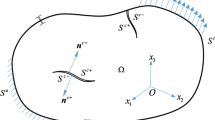Abstract
The analysis of two-dimensional and three-dimensional blunt crack problems in a linear viscoelastic medium is numerically investigated using the enriched finite element method. The enriched crack-tip elements are established by enriching the asymptotic displacement fields at the blunt crack front to the regular elements. The corresponding transition elements are formulated to eliminate displacement field incompatibility. The viscoelastic incremental formulations for the enriched finite element method in time domain are derived according to the Boltzmann superposition principle. The time-dependent deformations of crack are presented and the stress intensity factors are directly obtained from the enriched degree of freedoms. The numerical examples indicate that the enriched finite element method is extremely suitable for dealing with complicated blunt crack problems.
Similar content being viewed by others
References
S. M. Ohr, An electron microscope study of crack tip deformation and its impact on the dislocation theory of fracture. Mater. Sci. Eng., 72 (1985) 1–35.
L. L. Fischer and G. E. Beltz, The effect of crack blunting on the competition between dislocation nucleation and cleavage, J. Mech. Phys. Solids, 49 (2001) 635–654.
H. Wang and Z. Li, Diffusive shrinkage of a void within a grain of a stressed polycrystal, J. Mech. Phys. Solids, 51 (2003) 961–976.
M. Huang and Z. Li, Dislocation emission criterion from a blunt crack tip. J. Mech. Phys. Solids, 52 (2004) 1991–2003.
Y. Y. Zhang and G. H. Ruan, Boundary element method simulation and corrosion fatigue life prediction for 3-D blunt cracks, Acta Aeronaut. Astronaut. Sin., 15 (1994) 269–274.
M. Creager and P. C. Paris, Elastic field equations for blunt cracks with reference to stress corrosion cracking, Int. J. Fract., 3 (1967) 247–251.
Z. B. Kuang, The stress field near the blunt crack tip and the fracture criterion, Eng. Fract. Mech., 16 (1982) 19–33.
Z. Cui, Z. Zhang, S. Zheng, S. Jin and J. Xiong, The analysis of stress-strain field in a finite plate with a blunt crack, Eng. Fract. Mech., 19 (1984) 465–480.
Z. Li, C. Ji, Y. Li and L. R. Xu, The brittle fracture criterion based on the maximum tensile stress on the surface of blunt crack tip, Mech. Res. Commun., 34 (2007) 472–47.
S. Nakamura and R. S. Lakes, Finite element analysis of stress concentration around a blunt crack in a cosserat elastic solid, Comput. Method. Appl. Mech. Eng., 66 (1988) 257–266.
Y. Y. Zhang and G. H. Ruan, A calculation model and boundary element method simulation for 3-D blunt cracks, Eng. Fract. Mech., 47 (1994) 317–325.
S. E. Benzley, Representation of singularities with isoparametric finite elements, Int. J. Numer. Methods Eng., 8 (1974) 537–545.
A. O. Ayhan and H. F. Nied, Stress intensity factors for three-dimensional surface cracks using enriched finite elements, Int. J. Numer. Methods Eng., 54 (2002) 899–921.
A. O. Ayhan, Stress intensity factors for three-dimensional cracks in functionally graded materials using enriched finite elements, Int. J. Solids Struct., 44 (2007) 8579–8599.
A. O. Ayhan, Mixed-mode stress intensity factors for deflected and inclined corner cracks in finite-thickness plates, Int. J. Fatigue, 29 (2007) 305–317.
A. O. Ayhan, Three-dimensional mixed-mode stress intensity factors for cracks in functionally graded materials using enriched finite elements, Int. J. Solids Struct., 46 (2009) 796–810.
H. H. Zhang and L. X. Li, Modeling inclusion problems in viscoelastic materials with the extended finite element method, Finite Elem. Anal. Des., 45 (2009) 721–729.
C. Y. Zhang, Viscoelastic fracture mechanics, Second ed. Science Press, Beijing, China (2006).
O. C. Zienkiewicz, R. L. Taylor and J. Z. Zhu, The finite element method: Its Basis and Fundamentals, sixth ed. Elsevier, Butterworth-Heinemann (2005).
Author information
Authors and Affiliations
Corresponding author
Additional information
This paper was recommended for publication in revised form by Associate Editor Seong Beom Lee
Jingbo Duan received his B.S. and M.S. degrees from the National University of Defense Technology (NUDT), China, in 2005 and 2008, respectively. Mr. Duan is currently a Ph.D candidate in the College of Aerospace and Materials Engineering at the NUDT. His research interests include computational solid mechanics.
Yongjun Lei received his Ph.D in Computational Solid Mechanics at the National University of Defense Technology (NUDT), China, in 1999. During 2004 and 2005, he worked as a visiting scholar in the Department of Mechanical Engineering, University of Bristol in U.K. Dr. Lei is currently a professor in the College of Aerospace and Materials Engineering at the NUDT. His research interests include theory and application of computational solid mechanics and structural integrity analysis and storage life prediction of Solid Rocker Motor grain.
Rights and permissions
About this article
Cite this article
Duan, J., Lei, Y. & Li, D. Enriched finite element method for 2-D and 3-D blunt crack problems in a viscoelastic medium. J Mech Sci Technol 26, 869–882 (2012). https://doi.org/10.1007/s12206-011-0934-6
Received:
Revised:
Accepted:
Published:
Issue Date:
DOI: https://doi.org/10.1007/s12206-011-0934-6



